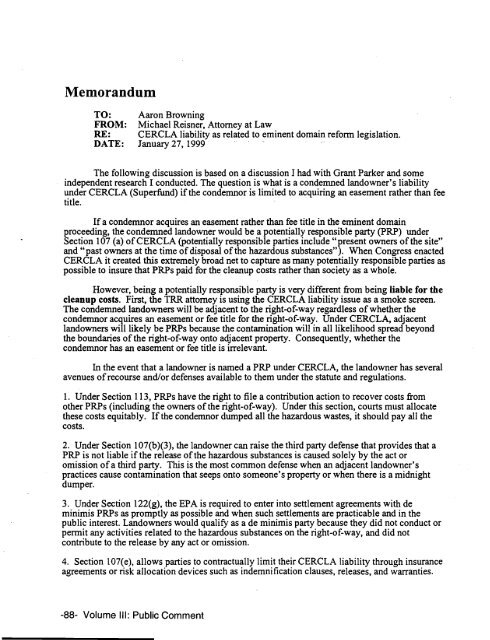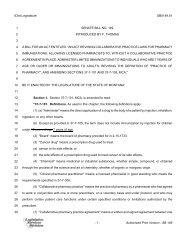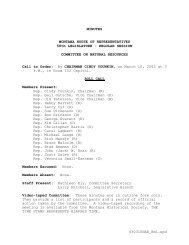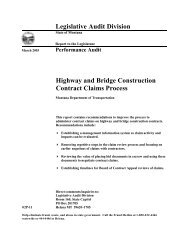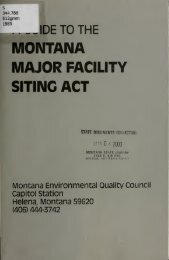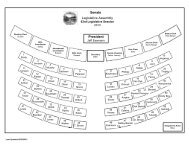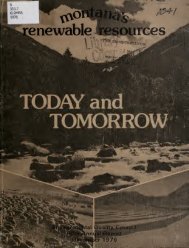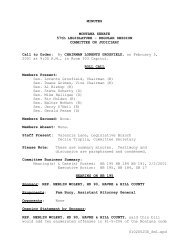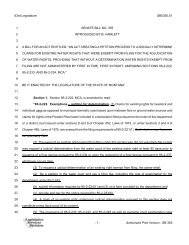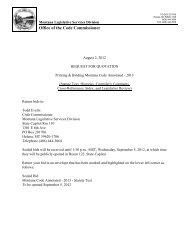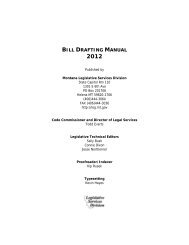Public Comment. Volume III - Montana Legislature
Public Comment. Volume III - Montana Legislature
Public Comment. Volume III - Montana Legislature
Create successful ePaper yourself
Turn your PDF publications into a flip-book with our unique Google optimized e-Paper software.
Memorandum<br />
TO: Aaron Browning<br />
FROM: Michael Reisner, Attorney at Law<br />
RE: CERCLA liability as related to eminent domain reform legislation.<br />
DATE: January 27, 1999<br />
The following discussion is based on a discussion I had with Grant Parker and some<br />
independent research I conducted. The question is what is a condemned landowner's liability<br />
under CERCLA (Superfhd) if the condemnor is limited to acquiring an easement rather than fee<br />
title.<br />
If a condemnor acquires an easement rather than fee title in the eminent domain<br />
proceeding, the condemned landowner would be a potentially responsible party (PRP) under<br />
Section 107 (a) of CERCLA (potentially responsible parties include "present owners of the site"<br />
and "past owners at the time of disposal of the hazardous substances"). When Congress enacted<br />
CERCLA it created this extremely broad net to capture as many potentially responsible parties as<br />
possible to insure that PRPs paid for the cleanup costs rather than society as a whole.<br />
However, being a potentially responsible party is very different fiom being liable for the<br />
cleanup costs. First, the TRR attorney is using the CERCLA liability issue as a smoke screen.<br />
The condemned landowners will be adjacent to the right-of-way regardless of whether the<br />
condemnor acquires an easement or fee title for the right-of-way. Under CERCLA, adjacent<br />
landowners will likely be PRes because the contamination will in all likelihood spread beyond<br />
the boundaries of the right-of-way onto adjacent property. Consequently, whether the<br />
condemnor has an easement or fee title is irrelevant.<br />
In the event that a landowner is named a PRP under CERCLA, the landowner has several<br />
avenues of recourse and/or defenses available to them under the statute and regulations.<br />
1. Under Section 1 13, PRPs have the right to file a contribution action to recover costs fiom<br />
other PRPs (including the owners of the right-of-way). Under this section, courts must allocate<br />
these costs equitably. If the condemnor dumped all the hazardous wastes, it should pay all the<br />
costs.<br />
2. Under Section 107(b)(3), the landowner can raise the third party defense that provides that a<br />
PRP is not liable if the release of the hazardous substances is caused solely by the act or<br />
omission of a third party. This is the most common defense when an adjacent landowner's<br />
practices cause contamination that seeps onto someone's property or when there is a midnight<br />
dumper.<br />
3. Under Section 122(g), the EPA is required to enter into settlement agreements with de<br />
minimis PRes as promptly as possible and when such settlements are practicable and in the<br />
public interest. Landowners would qualify as a de minimis party because they did not conduct or<br />
permit any activities related to the hazardous substances on the right-of-way, and did not<br />
contribute to the release by any act or omission.<br />
4. Section 107(e), allows parties to contractually limit their CERCLA liability through insurance<br />
agreements or risk allocation devices such as indemnification clauses, releases, and warranties.<br />
-88- <strong>Volume</strong> Ill: <strong>Public</strong> <strong>Comment</strong>


